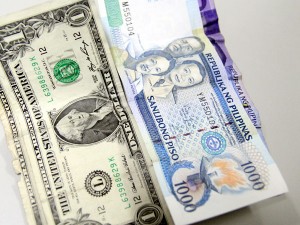MANILA — The peso on Monday shed five centavos to further weaken against the greenback, closing at 49.83:$1 and matching the almost eight-year low posted on Nov. 24, 2008 —during the height of the global financial crisis—still on the back of a looming US Fed rate hike.
“The peso depreciated slightly today (Nov. 21) still because of risk aversion amid US political uncertainties and concerns over the possibility of a US interest rate hike next month,” Land Bank of the Philippines market economist Guian Angelo S. Dumalagan said.
Last week, US Federal Reserve Chair Janet Yellen said the rate hike would be “relatively soon.”
At the start of the week, the peso hit an intraday low of 49.93:$1 and a high of 49.8:$1. It opened at 49.82:$1, following last Friday’s close of 49.78:$1.
The total volume traded dropped to $391.6 million from $812.9 million on Friday.
“For tomorrow, the exchange rate may move within the 48.70-50:$1 range. Trading might still be influenced by worries about December’s likely increase in the federal funds rate. Profit-taking, however, might cap the dollar’s appreciation,” Dumalagan added.
In a note to clients, Metrobank Research said the peso-dollar pair would likely trade within the range of 49-50.5:$1 this week.
For ING Bank Manila senior economist Joey Cuyegkeng, “external developments play a significant role in the peso’s weakness” although “there are local economic and non-economic factors,” including a deteriorating trade balance due to robust domestic demand.
“The strong domestic demand would keep overall economic growth at trend or above-trend. But the cost is a widening trade deficit. This also leads to importers, including [those] of capital equipment, to hedge forex liabilities and debt service. Risk to our structural inflows which are pillars of our strong external payment position in the past 10-12 years is rising with low oil prices, higher fiscal deficit in host economies and economic policies of the incoming US government an,d the uncertainty that surrounds it,” Cuyegkeng explained.
“Politics play a role, too. Cautiousness ahead of the expected Friday protests also affect US dollar supply and the peso,” Cuyegkeng added, referring to the planned bigger protests against the Nov. 18 hero’s burial of dictator Ferdinand Marcos at the Libingan ng mga Bayani, to coincide with the arrival of President Duterte from the Asia-Pacific Economic Cooperation Summit held in Lima, Peru.
“The risks are plenty and those are reflected in a weakening exchange rate,” Cuyegkeng said.
For BPI Asset Management, “as markets await particulars of [US President-elect Donald] Trump’s policies and as the impending rate hike draws near, we expect the US dollar to continue to strengthen.”
As such, “with foreign selling expected to continue in the coming week, we expect the peso to continue falling, potentially testing the 50:$1-level,” it said in a report. SFM



